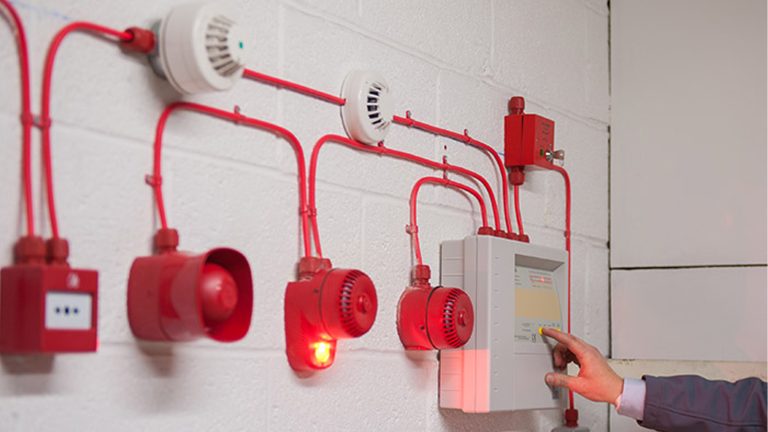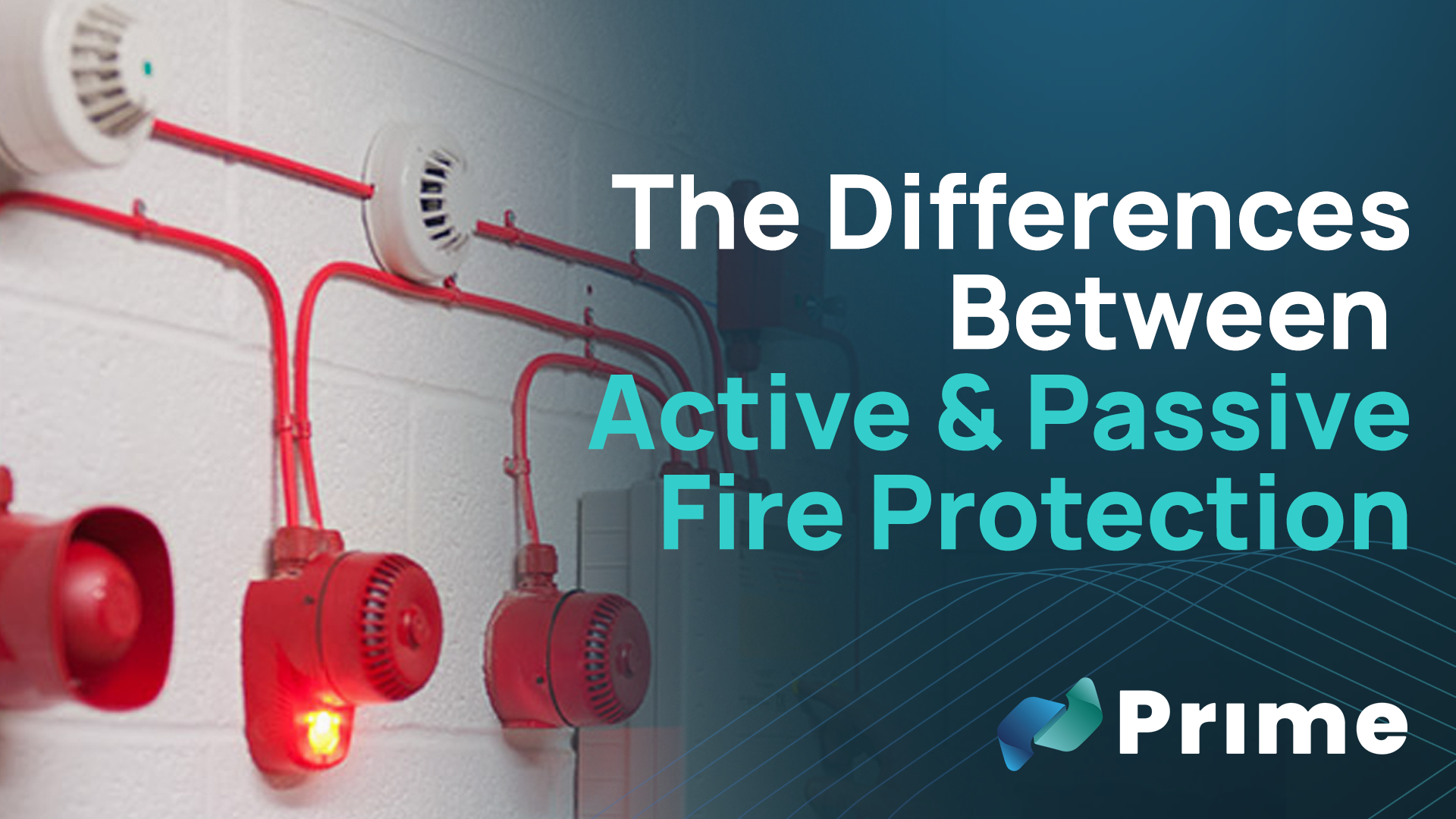Fire protection is a critical aspect of building safety and understanding the various strategies available to protect people and property is essential for anyone responsible for managing a building. Fire protection can generally be divided into two main categories: active fire protection (AFP) and passive fire protection (PFP). Although both approaches are crucial in ensuring fire safety, they operate in fundamentally different ways and serve distinct purposes.

What is Active Fire Protection?
Active fire protection refers to systems and measures that require some form of action or intervention to respond to a fire. These systems are designed to detect, suppress, or control fire as it occurs, helping to prevent the fire from spreading and minimising damage. Active fire protection typically involves mechanical or electronic systems that are triggered either automatically or manually.
Key Components of Active Fire Protection
Fire Alarms and Detection Systems:
Fire alarms and detection systems are essential components of active fire protection. These systems detect smoke, heat, or flames and activate alarms to alert occupants to the danger. Early detection is critical in providing people with enough time to evacuate the building safely and alert emergency services.
Sprinkler & Suppression Systems:
Sprinkler systems are one of the most common forms of active fire protection. When a fire is detected, these systems release water (or another fire-suppressant material) to control or extinguish the fire. Sprinklers are highly effective in containing fires to the area where they started, preventing them from spreading throughout the building.
Fire Extinguishers:
Fire extinguishers are portable devices that allow individuals to tackle small fires before they escalate. While they require manual operation, they are a crucial part of active fire protection, especially in environments where a quick response can prevent a fire from growing.
Smoke Control Systems:
Smoke control systems help manage the movement of smoke during a fire, keeping escape routes clear and reducing the risk of smoke inhalation for building occupants. These systems may include smoke curtains, ventilation systems, and pressurisation of stairwells.
Emergency Lights & Exit Signs:
Active fire protection also includes emergency lighting and illuminated exit signs that guide people to safety during an evacuation. These systems automatically activate in the event of a fire, ensuring that occupants can find their way out even in dark or smoke-filled conditions.
What is Passive Fire Protection?
Passive fire protection, on the other hand, involves building materials, structures, and design features that are integrated into the fabric of the building to slow the spread of fire and smoke. Unlike active fire protection, passive fire protection does not require any action or activation; it is always “on” and ready to perform its function. The primary goal of PFP is to compartmentalise the building, contain the fire to its point of origin, and maintain the structural integrity of the building for as long as possible.
Key Components of Passive Fire Protection
Fire Resistant Walls & Doors:
Fire-resistant walls and doors are designed to withstand fire for a specific period, usually measured in minutes or hours. These barriers help to compartmentalise the building, preventing the fire from spreading quickly from one area to another.
Fire Stopping:
Fire stopping involves sealing gaps and openings in walls, floors, and ceilings around pipes, cables, and ducts. Fire stopping materials expand when exposed to heat, creating a barrier that prevents flames and smoke from passing through these openings.
Structural Fire Protection:
Structural fire protection includes fireproof coatings, sprays, and cladding materials applied to structural elements like steel beams and columns. These materials help maintain the building’s integrity during a fire, reducing the risk of collapse.
Compartmentation:
Compartmentation involves dividing a building into separate sections or compartments, each isolated from the others by fire-resistant barriers. This design strategy slows the spread of fire, giving occupants more time to evacuate and firefighters more time to control the blaze.
The Differences Between Active and Passive Fire Protection
Functionality:
The primary difference between active and passive fire protection lies in their functionality. Active fire protection systems are dynamic; they detect, suppress, or control fires actively, often requiring some form of activation. Passive fire protection, however, is static; it is built into the building’s structure and works to contain the fire and protect the building’s integrity without any need for activation.
Activation:
Active fire protection systems typically require activation, whether through automatic systems like sprinklers and alarms or manual systems like fire extinguishers. Passive fire protection, by contrast, is always active and does not require any external triggers to function.
Maintenance:
Active fire protection systems often require regular maintenance and testing to ensure they function correctly in the event of a fire. Sprinklers, alarms, and other AFP systems need to be inspected periodically to maintain their effectiveness. Passive fire protection systems generally require less maintenance once installed, although they still need to be checked regularly to ensure they remain intact and effective.
The Scope of Impact:
Active fire protection systems focus on controlling or extinguishing the fire, minimising damage, and protecting lives. Passive fire protection, meanwhile, aims to contain the fire, limiting its spread and maintaining the building’s structural integrity to allow for safe evacuation and firefighting efforts.
The Importance of a Combined Approach
While active and passive fire protection serve different purposes, they are most effective when used together. A building equipped with both types of fire protection has a comprehensive safety net that can detect, contain, and suppress fires, protecting lives and property. For example, a fire may be detected by an active system like a smoke alarm, which alerts occupants and activates sprinklers. At the same time, passive systems like fire-resistant walls and doors contain the fire to a specific area, preventing it from spreading and giving emergency services time to respond.
Conclusion
Understanding the difference between active and passive fire protection is essential for anyone involved in building design, management, or safety. By integrating both approaches, you can create a robust fire protection strategy that ensures the safety of occupants and the preservation of property in the event of a fire.
Whether you’re constructing a new building or upgrading an existing one, consider the importance of both active and passive fire protection measures to create a safe and resilient environment. Here at Prime, we support construction companies, landlords and property managers with their fire safety strategies, ensuring their properties are up to date with the latest fire protection measures. Get in touch today for more information.




